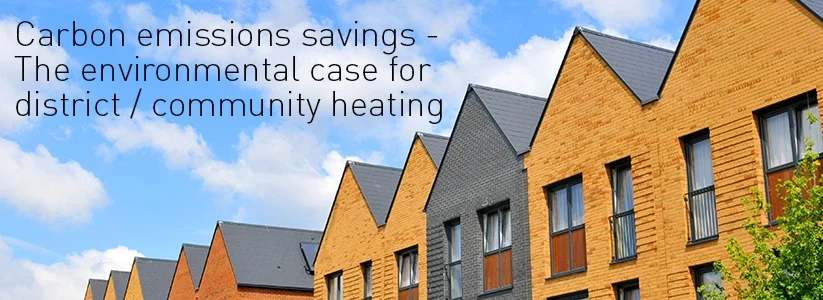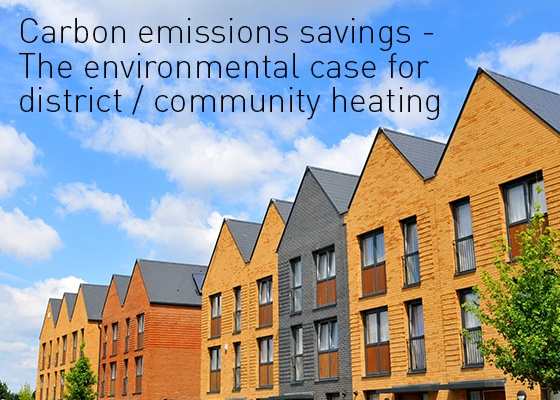
Community heating can save residents up to 60% on their heating bills. The role it can play to achieving the toughest targets for saving carbon emissions is equally impressive.
 Global powers are moving towards tougher, firmer targets on reducing carbon emissions in time for the UN Conference on Climate Change later this year. Their actions have been triggered by increasingly dire news about the impact of emissions on the environment.
Global powers are moving towards tougher, firmer targets on reducing carbon emissions in time for the UN Conference on Climate Change later this year. Their actions have been triggered by increasingly dire news about the impact of emissions on the environment.
As the experience of some Scandinavian countries shows, for example, this is where district and community heating can come into its own, driving up efficiency and reducing greenhouse gases.
International and European Targets on Climate Change Prevention
Encouraged by positive action from the world’s largest polluters, China and the US, EU leaders recently agreed to a higher target of cutting carbon emissions 40% by 2030 over 1990 levels, as well as a non-binding target of 27% improved energy efficiency.
These targets form the EU’s commitments to a renegotiated settlement on greenhouse gas emissions for the Paris UN Conference on Climate Change this November.
What part can community heating can play?
Community heating can save residents up to 60% on their heating bills compared with buying gas or electricity from a big supplier. Because the heating is more efficient, less carbon is emitted to heat people’s homes and water.
A 2009 report prepared for the Department of Energy and Climate Change (DECC) found that a district heating network covering 250,000 houses could save between 0.25 and 1.25 Mt CO2 a year compared to conventional heating systems.
In Sweden, for example, district and community heating began to be installed at scale during the ‘60s, growing 95% between 1960 and 2007. By the later date, 86% of energy delivered for heating purposes to multi-dwelling buildings was district heating, helping to halve CO2 emissions between 1970 and 1990 in Sweden to 6.07 tonnes.
How Community Heating cuts Carbon Emissions
One piece of kit for each development offers facilities managers more flexibility about the type of fuel and how it is burned as well as control over how the plant operates. Here’s how this helps to reduce carbon emissions.
Community heating is more efficient
A central boiler room is set up by expert installers, maintained by professional service engineers and the homes it serves are fitted with high-tech heating controls to provide all the required warmth.
Meanwhile, one centrally located boiler plant requires fewer carbon-emitting engineer trips to service than many smaller boilers.
The use of Combined Heat and Power
District and community heating schemes can be connected to waste heat from gas and coal-fired power stations.
Micro-scale CHP, where heat and electricity is generated together on-site is another option. It also runs on lower-emission natural gas.
Other sources of heat
As well as power stations, there are dozens of other district heating networks for developers to hook into, including excess heat from facilities including factories, power stations, hospitals and energy-from-waste plants.
UK Government Incentives
Some 210,000 of the UK’s 27m households currently benefit from being part of a district or community heat scheme and the Government wants to see up to 11m connected by 2050.
It has created a number of incentives intended to encourage the development of community and district heating bundled under the policy heading “community energy.”
They include:
The Renewable Heat Incentive (RHI)
This pays generators for heat to compensate for the higher costs of specialist boilers and fuel, some of which can be used in community heating. It covers lower-carbon options such as biomass, ground and water source heat pumps, geothermal, solar thermal, biomethane and biogas heating.
Energy Company Obligation (ECO)
The Carbon Saving Community Obligation, part of ECO, requires large energy suppliers to promote connection to district heating systems in low-income areas.
The Heat Network Delivery Unit (HNDU)
The Government’s HNDU provides funding for local authorities to develop early-stage proposals ready for investment.
The Community Energy Fund (CEF)
This £15m fund also helps support feasibility studies, this time for projects (including CHP) in rural areas.
The Urban Community Energy Fund
This £10m fund is to kick-start renewable projects in the urban UK.
Meeting Building Regulations
District and community heating schemes can help developers of new buildings meet carbon reduction targets if low environmental impact of heat supply can be achieved.
The DECC central heating fund
This fund helps people have access to central heating and successful local authorities can put grants towards upgrading to communal heating. Do we want to mention this?
Conclusion
District and community heating has made a relatively new appearance on the UK energy scene. But the experience of countries like Sweden shows it can really help countries that are still struggling to meet emissions targets.
Expect more interest - and hopefully continued incentives - from the UK Government in the months and years to come.
Takeaways:
- Europe and the UK have new, higher commitments to reduce carbon ahead of an urgent conference on climate change in November.
- District and community heating helped halve Sweden’s carbon emissions between 1970 and 1990.
- District and community heating can take advantage of more efficient and lower-carbon energy sources.
- The Government claims to want 11m households connected to a district or community heating scheme by 2050.
- It has put in place a number of incentives to help drive the uptake of district and community heating
Community heating offers affordable, reliable heat and savings in carbon emissions. But, poor decisions in the planning and design stage can severely reduce scheme profitability or lead to tariffs that are too high or too low.


